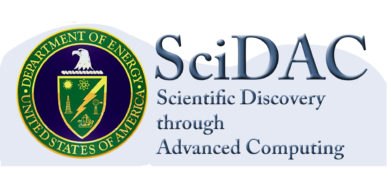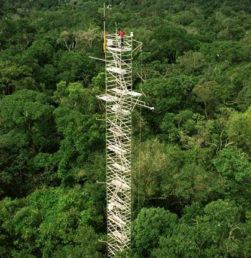Contributing to E3SM Refinement: SciDAC Awards Eight New Project Awards

Eight new projects were awarded under the Scientific Discovery through Advanced Computing (SciDAC) program, which is sponsored jointly by the Department of Energy’s Biological and Environmental Research (BER) and Advanced Scientific Computing Research (ASCR) programs. Two projects are large, five-year projects, and six are smaller pilot projects.
The six pilot projects will focus on improving representations of the atmospheric, land, or sea-ice components in the Energy Exascale Earth System Model (E3SM). As higher-risk projects, they are initially funded for 2.5 years, with the prospect of possible renewal.
From its inception, E3SM has relied on SciDAC to help solve cutting-edge numerical and computational problems. SciDAC supports cross-disciplinary teams of geophysical, computational, and mathematical scientists who contribute to advanced approaches in Earth system modeling.
Atmospheric Focus
 Three pilot projects will introduce changes in the E3SM atmospheric component, to allow use of very high horizontal resolution (grid scales < 10 kilometers) for more realistic simulation of atmospheric physics.
Three pilot projects will introduce changes in the E3SM atmospheric component, to allow use of very high horizontal resolution (grid scales < 10 kilometers) for more realistic simulation of atmospheric physics.
At such fine scales, the assumption of hydrostatic equilibrium—the approximate balancing of the atmospheric upward-pressure-gradient force by the downward gravitational force—no longer applies. A project headed by Peter Boster of Sandia National Laboratories (“Non-Hydrostatic Dynamics with Multi-Moment Characteristic Discontinuous Galerkin (NH-MMCDG) Methods”) therefore focuses on representing nonhydrostatic dynamics in E3SM. The proposed numerical algorithms are intended to work efficiently with diverse DOE computer architectures. A two-fold gain in performance is anticipated.
With finer horizontal resolution, an increase in E3SM vertical resolution also is desirable, especially for representing shallow stratocumulus and cirrus clouds that strongly impact Earth’s radiative balance. A project led by Takanobu Yamaguchi of the University of Colorado (“Adaptive Vertical Grid Enhancement for E3SM”) will dynamically adapt the number of vertical levels in each grid cell according to the local atmospheric state. This technique promises to reduce cloud biases equivalent to what can be achieved with a globally high-vertical-resolution simulation, but at substantially reduced computational cost.
Even with high-resolution grids, very fine-scale processes such, as cloud microphysics, must be parameterized—expressed in terms of resolved grid-scale variables. When parameterized processes are projected forward in time, their numerical accuracy can degrade sharply with increasing time-step length. A project headed by Hui Wan of Pacific Northwest National Laboratory (“Assessing and Improving the Numerical Solution of Atmospheric Physics in E3SM”) will attempt to improve the solution accuracy of E3SM atmospheric physics equations. The project will involve new time-integration schemes that will adopt both deterministic and stochastic solution approaches.
Land Focus
Two pilot projects are designed to improve the realism of E3SM simulation of terrestrial hydrology and biogeochemical cycling in the context of large observational uncertainties.
The first of these, led by Daniel Ricciutto of Oak Ridge National Laboratory (“Optimization of Sensor Networks for Improving Climate Model Predictions”) , aims to design an optimal observational measurement network to minimize E3SM uncertainties in predicting surface temperature and precipitation in selected regions. The project also seeks to identify those modeled land and atmospheric processes that are most responsible for these predictive uncertainties.
Gautam Bisht of Lawrence Berkeley National Laboratory (“Development of Terrestrial Dynamical Cores for the ACME to Simulate Water Cycle”) leads another effort to develop a high-resolution terrestrial component model to improve the accuracy of continental hydrology. To achieve this objective, the new land model will simulate three-dimensional flows of energy and water in the soil-plant continuum.
Sea Ice Focus
At high-horizontal resolution, the typical representation of sea ice on a grid no longer yields realistic simulations of ice dynamics and also suffers from computational inefficiencies. A project headed by Adrian Turner of Los Alamos National Laboratory (“A New Discrete Element Sea-Ice Model for Earth System Modeling”) will develop a new representation, where collections of ice floes and interspersed leads (open-water areas) are modeled as discrete elements. Their motion will be tracked in a Lagrangian (flow-following) framework and will be developed for computational efficiency.
Five-Year Projects
Steven Price of Los Alamos National Laboratory and Esmond Ng of Lawrence Berkeley National Laboratory are co-PIs of the ProSPect (“Probabilistic Sea-Level Projections from Ice Sheet and Earth System Models”) project. ProSPect will address the currently oversimplified physics of the E3SM ice sheet models, as well as its incomplete coupling with atmosphere and ocean components. The project also will devise new approaches for quantifying uncertainties in ice sheet dynamics that impact E3SM projections of future sea-level rise.
The CANGA (“Coupling Approaches for Next Generation Architectures”) project, headed by Philip Jones of Los Alamos National Laboratory, will develop a new approach for coupling the disparate E3SM components (atmosphere, ocean, land, sea ice, and continental ice), to better utilize high-performance computing architectures. The project also aims to devise improved methods for data transfer between E3SM components and for integrating the coupled components forward in time.
For more details on current SciDAC projects, see the DOE web page and included links.



